AMD is updating its newest series of desktop processors with an initial launch of four new parts. These new CPUs offer up to 5.7GHz speeds and the new AMD Zen 5 architecture. AMD put a focus on building higher performance cores and higher performance at a lower power consumption level for these parts.
AMD Rzyen 9000 Zen 5 CPUs Announced
Here are the SKUs that will be available July 31. As we can see these are still a maximum of 16 cores/ 32 threads per socket. AMD said it is sticking with SMT because, as it looks to boost performance/ watt, it is one of the best tools they have.
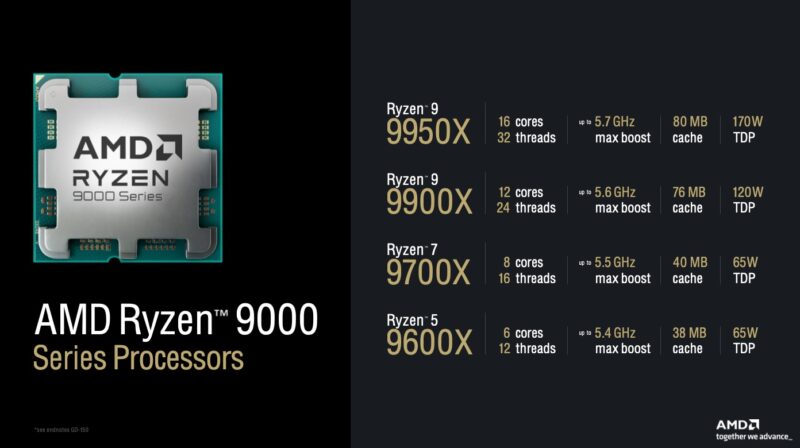
An example of this is that AMD is comparing the new AMD Ryzen 7 9700X to the AMD Ryzen 7 5800X3D, which is a two-generation old part with 3D V-Cache. That part is so popular that AMD is using it as a comparison point. I will note that while at the AMD Zen 5 event last week where this was presented (AMD flew me to Los Angeles for this), another attendee quipped, “So the answer is to wait for the 3D V-Cache version.” That is a challenge on the desktop processor side.

AMD says that it was able to drop power and add more performance in this generation due to the architectural shift.

AMD says its new Ryzen 9 9900X is faster than the Intel Core i9-14900K. The Core i9-14900K has seen stability challenges so for a lot of folks even being similar performance would be good enough right now.
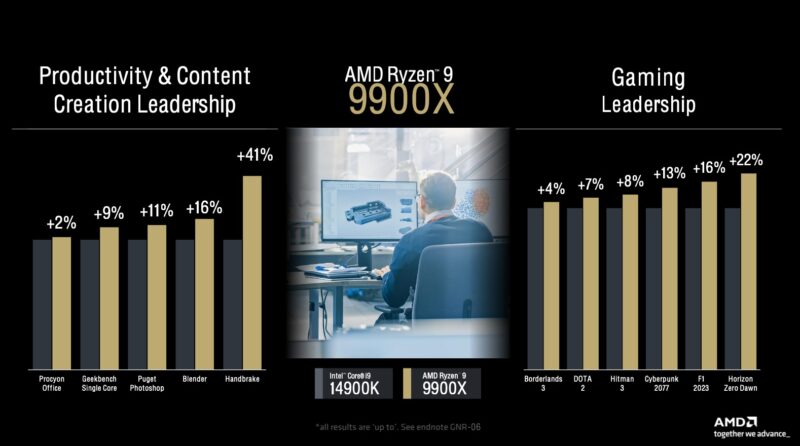
AMD says that Zen 5’s AVX-512 and VNNI support give its parts better LLM performance. These parts do not have the NPUs found on the AMD Ryzen AI 300 series.
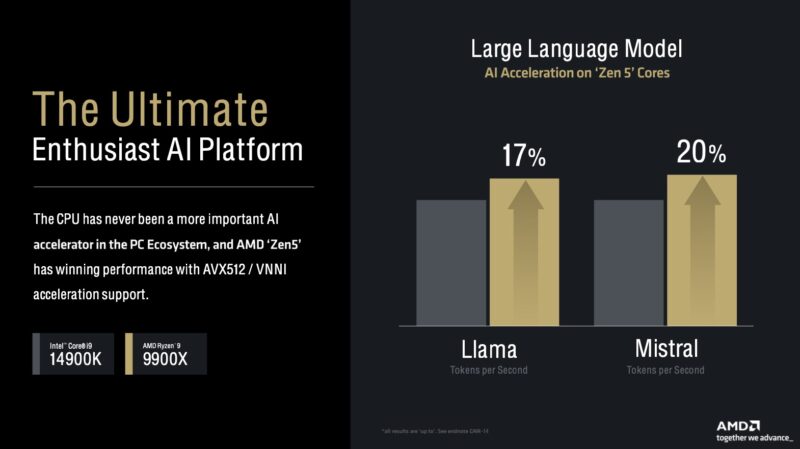
These are still AM5 parts. AMD has the AMD 800 Series chipset family, and highlights its flexibility. AMD said AM5 will continue to evolve into 2027.

Something interesting is that without a NPU, the way forward is going to be a PCIe GPU. This generation is going to push people more toward the APU parts with not just raw CPU performance but also enhanced iGPU and NPU features. At some point, sticking to AM5 becomes very interesting as the market for traditional CPUs might involve their I/O capacity as a major selling point. AM5 only has so many pins for PCIe.
Final Words
Normally, I would be extremely excited for a Ryzen launch, especially one with a new Zen architecture. In this generation, it feels like the AMD Ryzen AI 300 underwent a much bigger generational transformation.

AMD Ryzen AI 300 gets an upgraded GPU, NPU, and up to 12 cores that will enable Microsoft Copilot AI PC features. AMD EPYC Turin will scale to 192 cores later this year. We will wait for our parts, but the AMD Ryzen 9000 series feels like a much smaller incremental upgrade in this generation than the APU and server CPU markets will experience in 2024.


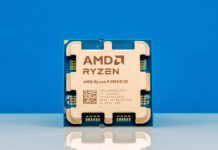

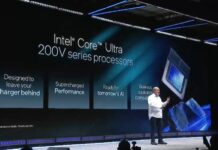
there is a prominent typo in the title
Until the ‘AI’ in ‘AI PC’ can do something like run a real full spec LLM this is all just marketing.
None of these NPU can do that yet.
Smartest thing AMD could do currently is release a turnkey NPU SDK that works out of the box (like seriously, ffs) with VS2019/2022 AND WITH A BULLETPROOF INSTALLER. Anyone at STH actually had the NPU SDK install go wrong? It’s insanely bad. But I digress, perhaps the punters can find some use for the NPU.
Did mention? AMD YOUR RYZEN AI SDK INSTALLER SUCKS! YOU HAVE MULTIPLE VERSIONS OF THE INSTALL INSTRUCTIONS IN GOOGLE TOP RESULTS AND MOST OF THEM RESULT IN NONFUNCTIONING SDK. I’ve 30 years exp with PCs and getting the AMD RYZEN AI SDK TO INSTALL CORRECTLY IS TOP 5 MOST FRAUGHT INSTALLS IN MY LIFE. HEY AMD! Lisa Su!
The problem I have is that the desktop version of Zen5 will uses RDNA2. Which really is the shame. My computer is not only a workstation, I do need the CPU power to do compiles. I don’t use the graphics capabilities so much that I would need an additional graphics card. The main problem with RDNA is the use of DisplayPort 1.4.